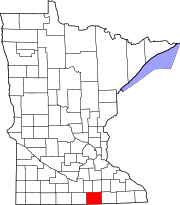
The Midwestern United States, also referred to as the Midwest or the American Midwest, is one of four census regions of the United States Census Bureau. It occupies the northern central part of the United States. It was officially named the North Central Region by the U.S. Census Bureau until 1984. It is between the Northeastern United States and the Western United States, with Canada to the north and the Southern United States to the south.

Freeborn is a city in Freeborn County, Minnesota, United States. The population was 264 at the 2020 census.

Marshall is a city in Lyon County, Minnesota, United States. The population was 13,628 at the 2020 census. Marshall is a regional center in southwest Minnesota, and the county seat of Lyon County. It is the headquarters of the Schwan Food Company and the home of Southwest Minnesota State University.

Olivia is the county seat of Renville County, Minnesota, United States. Its population was 2,484 at the 2010 census.

Cokato is a city in Wright County, Minnesota, United States. The population was 2,799 at the 2020 census.

Granite Falls is a city located mostly in Yellow Medicine County, Minnesota, of which it is the county seat with a small portion in Chippewa County, Minnesota. The population was 2,737 at the 2020 census. The Andrew John Volstead House, a National Historic Landmark (NHL), is located in Granite Falls. Another NHL located in Granite Falls is the Julian A. Weaver House.

The Minnesota River is a tributary of the Mississippi River, approximately 332 miles (534 km) long, in the U.S. state of Minnesota. It drains a watershed of 14,751 square miles (38,200 km2) in Minnesota and about 2,000 sq mi (5,200 km2) in South Dakota and Iowa.

The Upper Midwest is a region in the northern portion of the U.S. Census Bureau's Midwestern United States. It is largely a sub-region of the Midwest. Although the exact boundaries are not uniformly agreed-upon, the region is usually defined to include the states of Michigan, Minnesota and Wisconsin; some definitions include Iowa, North Dakota, South Dakota, and parts of Nebraska and Montana as well.

The Corn Belt is a region of the Midwestern United States and part of the Southern United States that, since the 1850s, has dominated corn production in the United States. In North America, corn is the common word for maize. More generally, the concept of the Corn Belt connotes the area of the Midwest dominated by farming and agriculture.

Gunnar Birkerts was a Latvian American architect who, for most of his career, was based in the metropolitan area of Detroit, Michigan.
Hazel is an unincorporated community in Pennington County, Minnesota, United States, along the Canadian Pacific Railway. The community is only marked on county abstracts and has no postal code. Hazel is the location of a Cenex Harvest States shipping facility.

Charles Henry Berry, widely known as C. H. Berry, was an American politician and jurist who served as the first Minnesota Attorney General after statehood and as one of the last justices of the Idaho Territorial Supreme Court.

A corned beef sandwich is a Jewish deli sandwich filled with corned beef, traditionally served with mustard and a pickle.

Maize, also known as corn in North American and Australian English, is a tall stout grass that produces cereal grain. It was domesticated by indigenous peoples in southern Mexico about 9,000 years ago from wild teosinte. Native Americans planted it alongside beans and squashes in the Three Sisters polyculture. The leafy stalk of the plant gives rise to male inflorescences or tassels which produce pollen, and female inflorescences called ears which yield grain, known as kernels or seeds. In modern varieties, these are usually yellow or white; other varieties can be of many colors.

A corn roaster is a large grill for cooking large batches of ears of corn at the same time. The term "corn roaster" can also refer to a person who roasts corn. Corn roaster machines have existed in the United States since at least 1900. Corn roasters are used by concession vendors at festivals, fairs, events, parties, and holidays, such as the Fourth of July in the United States. Roasted corn is a very popular festival food in the American South, Southwest, and Northwest. Corn roasters can also cook foods such as turkey legs, potatoes, and sweet potatoes. They may also be used by street food vendors. Street vendors may operate seasonally, per the seasonality of corn crops. Some organizations that operate corn roasters at events, such as fairs, donate their proceeds to charities.

The 1862–63 United States Senate elections were held on various dates in various states, occurring during the American Civil War. As these U.S. Senate elections were prior to the ratification of the Seventeenth Amendment in 1913, senators were chosen by state legislatures. Senators were elected over a wide range of time throughout 1862 and 1863, and a seat may have been filled months late or remained vacant due to legislative deadlock. In these elections, terms were up for the senators in Class 1.

The production of corn plays a major role in the economy of the United States. The US is the largest corn producer in the world, with 96,000,000 acres (39,000,000 ha) of land reserved for corn production. Corn growth is dominated by west/north central Iowa and east central Illinois. Approximately 13% of its annual yield is exported.
Angie's BoomChickaPop PopCorn is a brand of kettle corn produced for Angie's Artisan Treats, Minnesota.

Maple Island is an unincorporated community in Freeborn County, Minnesota, United States. It is located within Newry Township and Moscow Township.

Climate change in Minnesota encompasses the effects of climate change, attributed to human-caused increases in atmospheric carbon dioxide, in the U.S. state of Minnesota.





















